Hippiebabe
New Member
So are veiled’s colors and patterns predetermined or will him growing up with certain plant colors around him change how he develops? This is my Mojo-Jojo currently. I just adopted him and was told he’s around 2 years old
Follow along with the video below to see how to install our site as a web app on your home screen.
Note: This feature may not be available in some browsers.
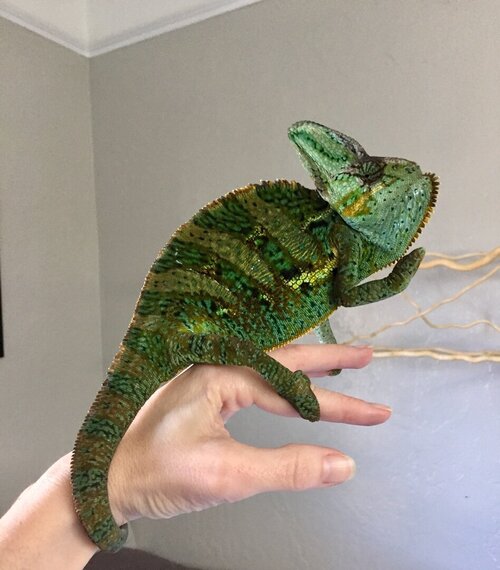
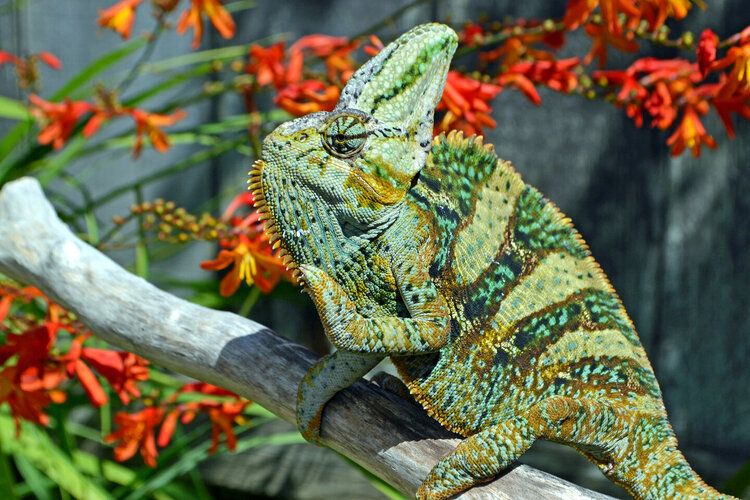
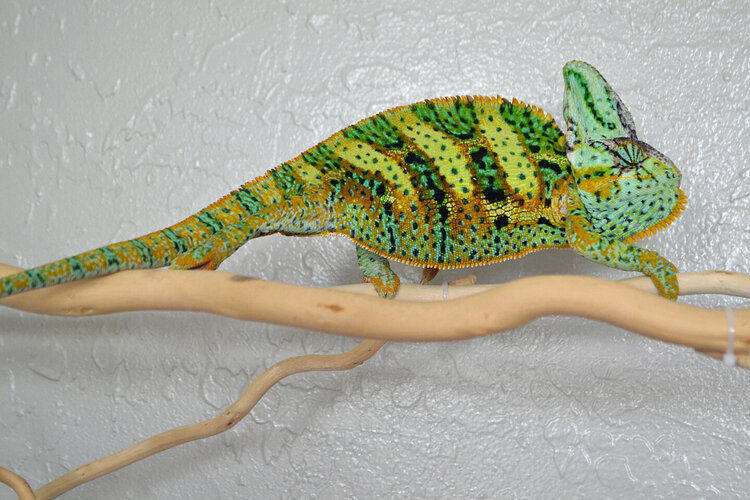
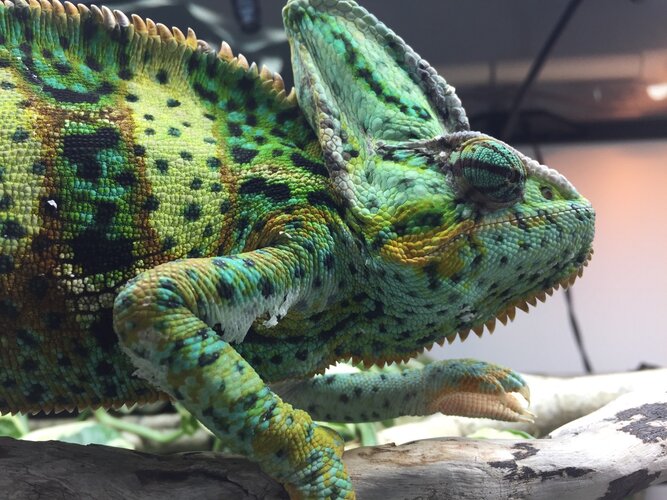
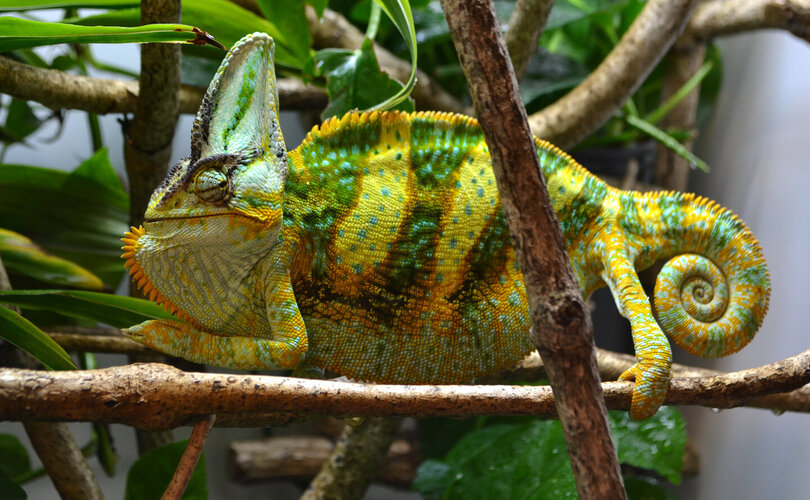
So he won’t develop more colors or more to his pattern as he ages?His pattern is his pattern. The colors are going to depend on if he is calm resting colors, basking, or pissed off. They change color based off mood and environmental changes and they will not ever change to match the environment around him...
example...
Resting colors: More muted and duller still showing pattern.
View attachment 318878
Basking colors: still showing pattern but can go brownish especially when they are younger.
View attachment 318873
And pissed: this is when they fully fire up. Can be over their territory, a change in environment, or seeing another cham. This can very in color shades of yellows, oranges, teals, and greens, and almost always includes striking dot patterns.
View attachment 318874View attachment 318875View attachment 318876
At 2 years old he has fully matured. There will not be any drastic changes other than those related to what I mentioned above. All of the pics up there that I posted are of the exact same chameleon after he reached 2 years old. Same cham different coloring based on external stimuli.So he won’t develop more colors or more to his pattern as he ages?
Plant colors have nothing to do with it; it's all genetic. By this age, the colors he is capable of producing are likely set, though some may rarely be seen.So are veiled’s colors and patterns predetermined or will him growing up with certain plant colors around him change how he develops? This is my Mojo-Jojo currently. I just adopted him and was told he’s around 2 years old
Well said .. great post..At 2 years old he has fully matured. There will not be any drastic changes other than those related to what I mentioned above. All of the pics up there that I posted are of the exact same chameleon after he reached 2 years old. Same cham different coloring based on external stimuli.
Huh. Interesting. Reminds me of Bearded Dragons' ability to learn by watching other beardies. Not saying it's the same thing—IDK. Beardies are solitary in the wild, but can learn from each other in captivity.There is some research into raising veiled chameleons in isolation compared to with their siblings. With the conclusion that those raised alone showing duller & darker colours compared to those raised in a social group developing more vivid colours as well as better foraging skills Its thought to be because they develop a social hierarchy & communication through their colours.
Huh... again. How much younger? Before getting my panther, what I was reading (including here on CF recommended 3 mo. for any of the "Big 3".Veiled chameleons tend to be sold much younger than other species not having developed their full potential in colour
Huh. Interesting. Reminds me of Bearded Dragons' ability to learn by watching other beardies. Not saying it's the same thing—IDK. Beardies are solitary in the wild, but can learn from each other in captivity.
https://www.livescience.com/48165-bearded-dragons-imitation.html
Huh... again. How much younger? Before getting my panther, what I was reading (including here on CF recommended 3 mo. for any of the "Big 3".
I’ll have to read the article, but something doesn’t sound right. Colour is a genetically determined trait. I’m sure exposure to harsh sun can cause sunburn like in us, but group raising seems an unlikely candidate for exerting any influence on chromatophores. Just my initial thoughts; I’ll read the article.There is some research into raising veiled chameleons in isolation compared to with their siblings. With the conclusion that those raised alone showing duller & darker colours compared to those raised in a social group developing more vivid colours as well as better foraging skills Its thought to be because they develop a social hierarchy & communication through their colours.
Veiled chameleons tend to be sold much younger than other species not having developed their full potential in colour
https://www.researchgate.net/public...nce_of_juvenile_lizards_Chamaeleo_calyptratus
That explains it. I only buy from vetted breeders, and avoid big-box.Veiled are more readily available as hatchlings for sure not from reputable breeders.
Above was the first link; SLoP may have been further down.I seen beardies learning by video on secret life if pets
I didn't read it (post #8) as different colors as much as the display/expression of colors.I’ll have to read the article, but something doesn’t sound right. Colour is a genetically determined trait. I’m sure exposure to harsh sun can cause sunburn like in us, but group raising seems an unlikely candidate for exerting any influence on chromatophores. Just my initial thoughts; I’ll read the article.
Colour maybe determined but the learning to use the colour range might be what's differentI’ll have to read the article, but something doesn’t sound right. Colour is a genetically determined trait. I’m sure exposure to harsh sun can cause sunburn like in us, but group raising seems an unlikely candidate for exerting any influence on chromatophores. Just my initial thoughts; I’ll read the article.
Meh.... I have had multiple Veileds... They all fired up over different triggers. And the patterns and color ranges that they displayed were different. But to your point. My boy that was separated from clutch mates by the breeder at a young age fired up the most out of all three. In fact for him it did not take much at all for him to fully fire up.Colour maybe determined but the learning to use the colour range might be what's different
Yup! Individually raised chameleons don’t flash those stress out colours as often…. Also, now that I looked at it, I recognize the relevant paper. It was given pretty poor reviews from the scientific and expert community. It’s great that literature was cited, but unfortunately, this particular paper was kind of an empirical mess.I didn't read it (post #8) as different colors as much as the display/expression of colors.
I'm not saying that right.
E.g. Dark red, red, light red, vivid red...